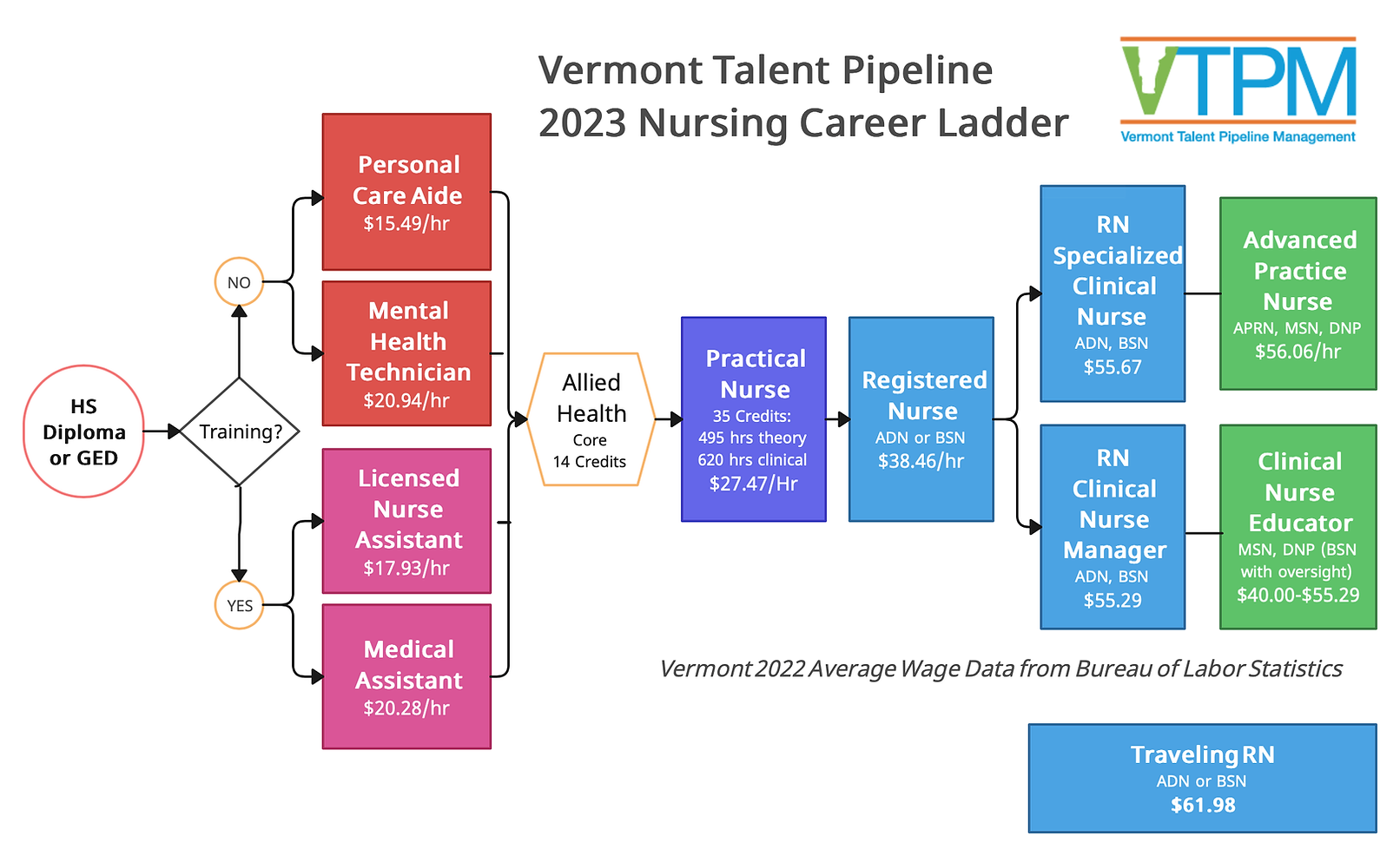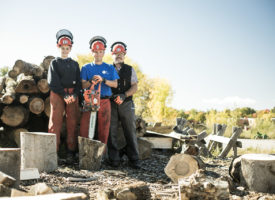Every other year, the Vermont Department of Labor and the J. Warren & Lois McClure Foundation partner to identify a list of the most promising jobs in Vermont. Comprising over 50 jobs, the list includes occupations that are projected to be hiring for at least 500 positions over the next 10 years and pay a median wage of at least $22.55 per hour.
The pathways that lead to four of these promising careers were spotlighted in a series by VTDigger. While each of the careers require a form of postsecondary education or training, the routes taken to lead to any one job can vary significantly.
Advance Vermont’s Executive Director Tom Cheney was asked to provide insights on job opportunities in Vermont, and the education pathways leading to them. Also highlighted in the series is MyFutureVT.org, Advance Vermont’s free education and career resource for Vermonters — which provides a centralized location for individuals to learn the details about the top 500+ jobs found in Vermont and the education programs to help them meet their goals.
Teaching
Teaching is one of the most in-demand occupations in Vermont, with an anticipated 7,850 openings expected over the coming 10 years. There are over eight unique teaching specialties that make up this high-pay, high-demand occupation, from Kindergarten special education to high school career and technical education teachers. Right now, the supply of qualified teachers is far from meeting demand in the state.
Former Randolph Elementary School Principal Erica McLaughlin told VTDigger that, ‘years ago, she would receive 90 to 100 applications a year for teaching jobs. But in recent years, the pool of applicants has been much smaller.’
Kelli Dean, principal of Richford Elementary, told VTDigger that the school went into the 2022-2023 academic year with teacher positions unfilled. Because of it, they had to combine classrooms and combine grade levels.
Though teaching has education requirements to gain licensure by the State of Vermont, including a bachelor’s degree, the training pathways can vary from teacher apprenticeship to an undergraduate degree in an unrelated field.
According to the State of Vermont Agency of Education, the traditional path to teacher licensure is “determined by the completion of a state approved educator preparation program at a college or university through a bachelor, post-baccalaureate or master’s degree program and recommendation for licensure from the institution.” However, the state also offers a “Peer Review” track that allows licensure-seekers to complete a portfolio, which is then reviewed by a panel of experienced teachers.
VTDigger’s article notes that many of Vermont’s teachers do not take a linear path to the profession. Today’s educators are often career-changers, or upskillers who add teacher licensure to their existing specialty. Education and training programs for those seeking a pathway to licensure through a traditional education program can be found on MyFutureVT.
Bookkeeping
In Vermont, bookkeeping is one of the most promising careers with the shortest investment in education required.
Typically, a short-term certificate program is sufficient to enter the profession. The Community College of Vermont (CCV) offers two pathways to bookkeeping: a one-year certificate and a 1.5 to 2 year apprenticeship training program. With this brief education investment, Vermonters can expect to enter a field hiring for over 5,000 positions through 2030 — about 530 positions each year — with a median wage of $23 per hour.
Michael Keogh, director of business engagement at CCV, told VTDigger that independent bookkeepers generally earn anywhere from $30 to $50 per hour. But working for a firm is also an option for bookkeepers who may not want to own their own business.
Cookie baker turned independent bookkeeper Kaela Coble enjoys the flexibility and social aspect of the job, and notes that you do not have to be a math genius to do well in this profession.
“I love everything about the work,” she said to VTDigger. “I love work and I love organization. I love money and talking about money.”
Bookkeeping is a field particularly ripe for those interested in an education path involving stacking credentials. Going beyond the CCV bookkeeping programs, students could consider stacking other short term credentials in QuickBooks or accounting to bolster their industry knowledge and stand out among job applicants.
Nursing
Similar to careers in teaching, there are many different pathways that can lead to nursing — and numerous tracks within the field itself. For registered nurses alone, there are expected to be 4,460 openings from 2020 through 2030 — while the state only graduates 300 to 400 nurses per year through programs at Vermont State University, Norwich University, and University of Vermont, Vermont Talent Pipeline Management Director Mary Anne Sheahan told VTDigger.
Demand for career technical education programs at Vermont high schools that allow students to get a head start on earning college credit is also high.
“This year, the Health Science Academy program [at Burlington Technical Center] had 38 applicants for 23 seats,” says VTDigger. But while nearly all students in the program enroll in college, only 25% to 50% of students undertake a postsecondary nursing program.
In an effort to help meet the critical nursing demand, both Vermont health care providers and state institutions have sought to make entering the field as accessible as possible.
VTDigger reports that Central Vermont Medical Center works to get entry-level support employees onboard, and then pays for them to pursue a nursing education. Vermont State University offers a nursing re-entry certificate, an in-person associate degree program at 10 locations throughout the state and one in New Hampshire, both an in-person and online nursing bachelor’s and master’s degree, and a hybrid practical nursing certificate program.
VTDigger also shares that Sheahan has worked with education and health care partners to develop an apprenticeship program, in which students can earn money while they learn, at four Vermont hospitals thus far.
Vermont nursing education programs at both colleges and career technical education centers can be found on MyFutureVT.org.

The nursing profession offers an entry point for anyone with a high school diploma or who have passed the General Educational Development (GED) test.
Carpentry
Though there is a steady supply of students for carpentry programs at career and technical education centers across the state, one major contributor to the throttled Vermont carpentry pipeline is a lack of teachers for the next generation.
According to VTDigger’s interview with Cold Hollow Career Center Director Nate Demar, this high-pay, high-demand career has some entry-level employees earning $45,000 to $64,000 fresh out of high school — which is the salary range for a bachelor’s degree holding teacher with no experience, to a seasoned teacher with 20 years of experience. And so, teaching can be a hard sell for those qualified to earn well beyond that income cap.
But while the career and technical center education is enough to get new graduates employed, it’s not enough to work as a fully-fledged carpenter. Meeting that need, Sheahan told VTDigger that she collaborated with contractors to develop an 18-month apprenticeship designed to stack with students’ existing construction credential.
Other apprenticeship programs are available at employers throughout the state, and also through ReSOURCE — which also offers a short-term Construction 101 workshop. The workshop provides a direct pipeline to open job opportunities, allowing for a seamless transition from education to employment.
In Vermont, there are 4,460 projected job openings in carpentry from 2020 to 2030, with a median wage of $23 per hour. Education pathways to carpentry can also be found on MyFutureVT.org, including through career and technical education centers and other entities in the state.





